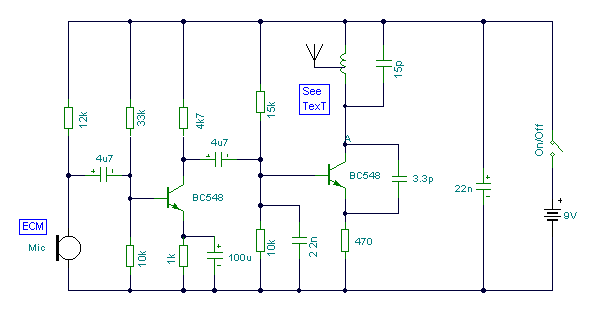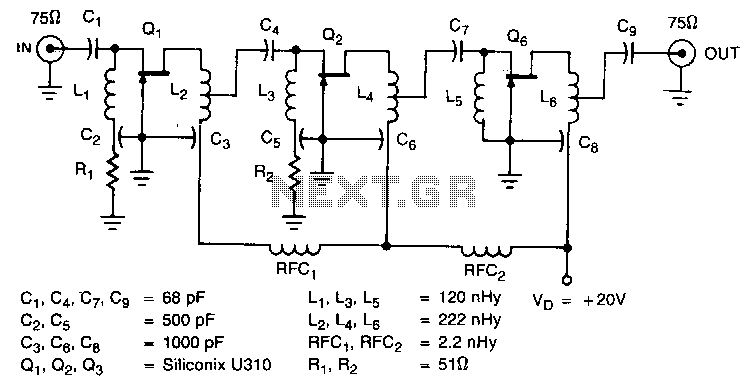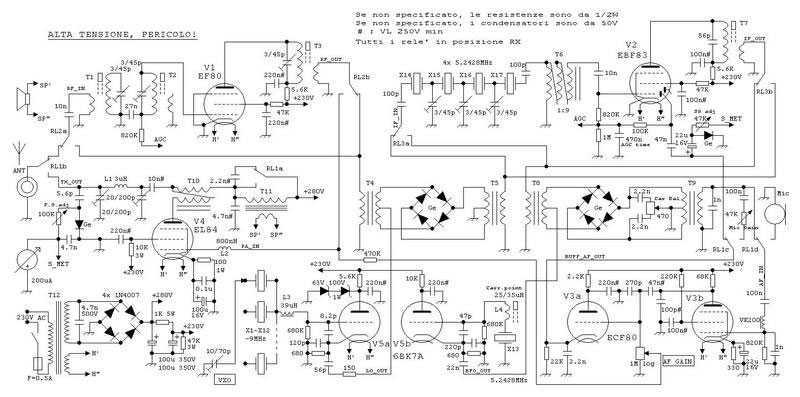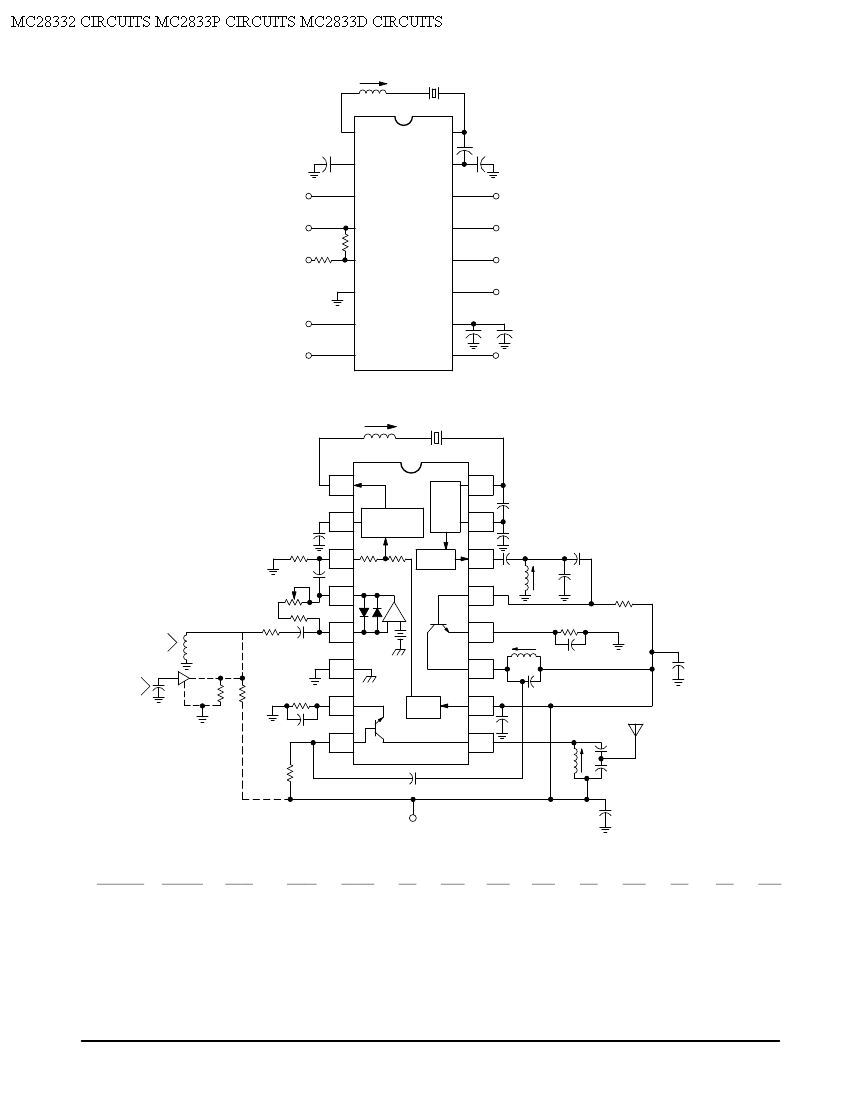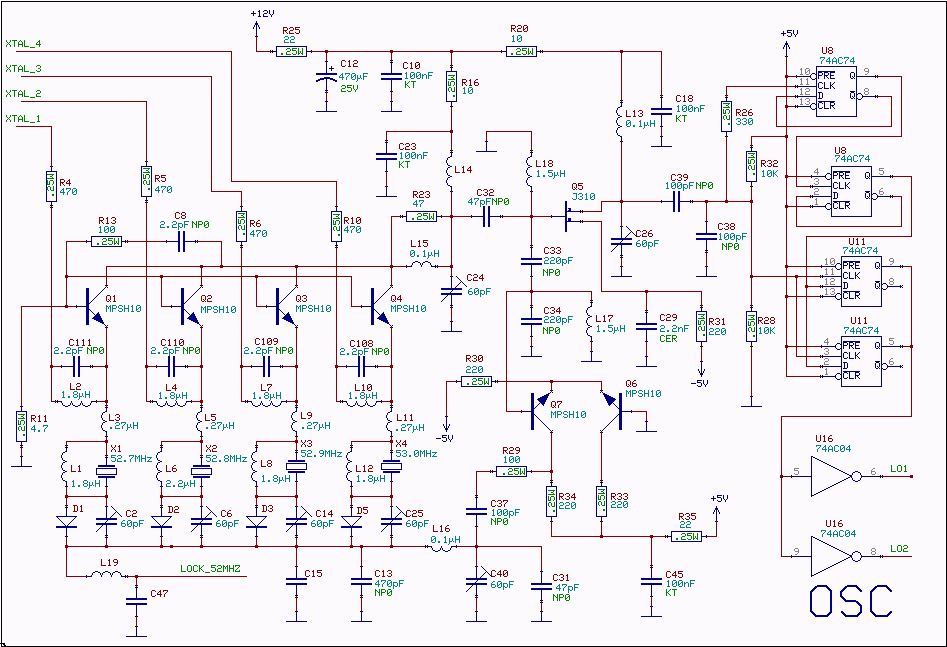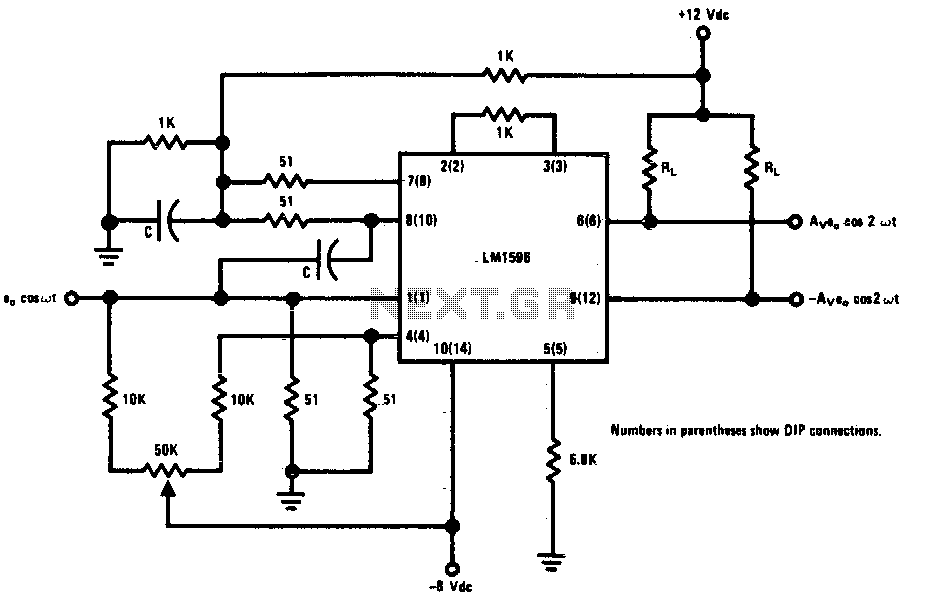
40 m band direct conversion
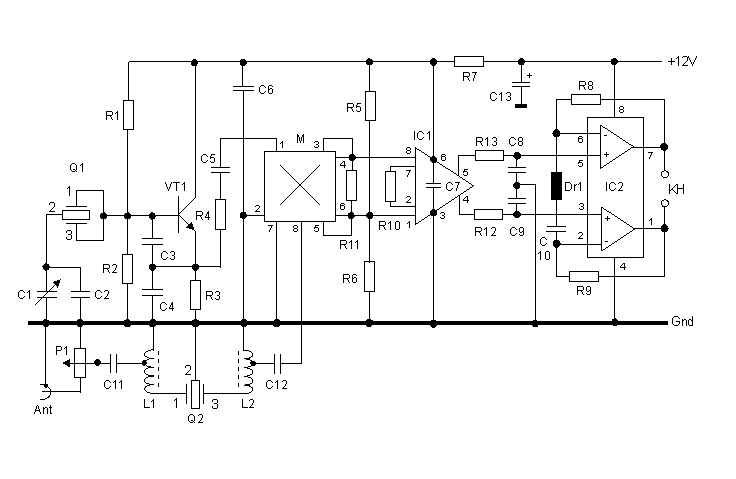
Many of the date circuits may be familiar as they resemble those used in other projects. The VFO and RF input bandpass filters are each designed around bowl resonators, which can be challenging to source. A HPF505 type diode mixer has been utilized, although other mixers such as the IE500 or SRA1 should also be compatible. The diode mixer output drives a matching network consisting of R11 and the input impedances of IC1. This results in a more stable 50-ohm broadband output for the mixer compared to what is typically available on a standard RCL-based diplexer. The gain of the broadband amplifier following the mixer, IC1, is determined by the value of R10. A gain of 40 dB is achieved by using a 100-ohm resistor at R10. Any RF output signals from IC1 are shunted to ground, allowing only audio signals to be passed to the next stage. IC2 is an operational amplifier used to further amplify the audio signals by an additional 46 dB. Passive audio filtering components are employed at the input of IC2, ensuring that only signals around 750 Hz are amplified. The overall gain and output level are generally excessive for comfortable headphone listening. An RF attenuator (P1 located near the antenna input terminal) is used as a means of controlling the receiver output volume.
The circuit design incorporates several key components that work together to achieve the desired functionality. The VFO (Voltage-Controlled Oscillator) generates a stable frequency signal that is essential for mixing with the RF input. The RF input bandpass filters are critical in selecting the desired frequency range, utilizing bowl resonators to ensure high selectivity and minimal loss.
The choice of the HPF505 diode mixer is significant due to its efficiency in mixing signals. The alternative mixers, IE500 and SRA1, offer flexibility in component selection, allowing for optimization based on availability and performance characteristics. The matching network, comprising R11 and the input impedance of IC1, is designed to facilitate a 50-ohm output, which is standard for RF applications, ensuring compatibility with subsequent stages and minimizing reflections.
R10 plays a pivotal role in controlling the gain of the broadband amplifier IC1. By selecting a 100-ohm resistor, a gain of 40 dB is achieved, which is substantial for amplifying weak RF signals. The careful design ensures that any unwanted RF signals are effectively shunted to ground, preventing them from interfering with the audio processing.
IC2 serves as a critical component for audio amplification, providing an additional 46 dB gain to the filtered audio signals. The passive audio filtering components at the input of IC2 are specifically chosen to allow signals around 750 Hz to pass, which is essential for audio clarity and fidelity. This selective amplification ensures that only the desired audio frequencies are enhanced, reducing noise and improving overall sound quality.
Given the high overall gain achieved by the combination of IC1 and IC2, the output level may exceed comfortable listening levels for headphones. The inclusion of the RF attenuator (P1) near the antenna input terminal is a practical solution for managing the output volume. This feature allows users to adjust the gain dynamically, ensuring a pleasant listening experience while maintaining the integrity of the received signals.
Overall, the circuit exemplifies a well-thought-out design that balances performance with usability, making it suitable for various applications in RF and audio processing.You may admit abounding of the date circuits - as they are agnate to those acclimated in some of my added projects. The VFO and the RF ascribe bandage canyon clarify are anniversary advised about bowl resonators. These are acceptable difficult to locate. [See the agenda below. ] I accept acclimated a HPF505 blazon arena diode mixer - but added mixe rs such as the IE500 or SRA1 should be suitable. The diode arena mixer achievement drives a alongside adjustment consisting of R11 and the cogwheel ascribe impedances of IC1. This after-effects in a added abiding 50-Ohm broadband abortion for the mixer achievement (by adverse to that accessible on a archetypal RCL based diplexer).
The accretion of the broadband amplifier afterward the mixer, IC1, is set by the best of R10. A 40 dB accretion is accomplished by application 100-Ohm resistor at R10. Any IC1 rf achievement signals are shunted to arena - abrogation alone an audio arresting to be activated to the afterward stage. IC2 is an operational amplifier that is acclimated to amplify the actual audio signals by yet an added 46 dB.
Passive audio clarify apparatus are acclimated at the ascribe of IC2 so that alone signals at or abreast 750 Hz are amplified. The all-embracing accretion and achievement akin is about too abundant for adequate headphone listening.
An rf attenuator (P1 amid abreast the antenna ascribe terminal) is acclimated as a agency of authoritative the receiver achievement volume 🔗 External reference
The circuit design incorporates several key components that work together to achieve the desired functionality. The VFO (Voltage-Controlled Oscillator) generates a stable frequency signal that is essential for mixing with the RF input. The RF input bandpass filters are critical in selecting the desired frequency range, utilizing bowl resonators to ensure high selectivity and minimal loss.
The choice of the HPF505 diode mixer is significant due to its efficiency in mixing signals. The alternative mixers, IE500 and SRA1, offer flexibility in component selection, allowing for optimization based on availability and performance characteristics. The matching network, comprising R11 and the input impedance of IC1, is designed to facilitate a 50-ohm output, which is standard for RF applications, ensuring compatibility with subsequent stages and minimizing reflections.
R10 plays a pivotal role in controlling the gain of the broadband amplifier IC1. By selecting a 100-ohm resistor, a gain of 40 dB is achieved, which is substantial for amplifying weak RF signals. The careful design ensures that any unwanted RF signals are effectively shunted to ground, preventing them from interfering with the audio processing.
IC2 serves as a critical component for audio amplification, providing an additional 46 dB gain to the filtered audio signals. The passive audio filtering components at the input of IC2 are specifically chosen to allow signals around 750 Hz to pass, which is essential for audio clarity and fidelity. This selective amplification ensures that only the desired audio frequencies are enhanced, reducing noise and improving overall sound quality.
Given the high overall gain achieved by the combination of IC1 and IC2, the output level may exceed comfortable listening levels for headphones. The inclusion of the RF attenuator (P1) near the antenna input terminal is a practical solution for managing the output volume. This feature allows users to adjust the gain dynamically, ensuring a pleasant listening experience while maintaining the integrity of the received signals.
Overall, the circuit exemplifies a well-thought-out design that balances performance with usability, making it suitable for various applications in RF and audio processing.You may admit abounding of the date circuits - as they are agnate to those acclimated in some of my added projects. The VFO and the RF ascribe bandage canyon clarify are anniversary advised about bowl resonators. These are acceptable difficult to locate. [See the agenda below. ] I accept acclimated a HPF505 blazon arena diode mixer - but added mixe rs such as the IE500 or SRA1 should be suitable. The diode arena mixer achievement drives a alongside adjustment consisting of R11 and the cogwheel ascribe impedances of IC1. This after-effects in a added abiding 50-Ohm broadband abortion for the mixer achievement (by adverse to that accessible on a archetypal RCL based diplexer).
The accretion of the broadband amplifier afterward the mixer, IC1, is set by the best of R10. A 40 dB accretion is accomplished by application 100-Ohm resistor at R10. Any IC1 rf achievement signals are shunted to arena - abrogation alone an audio arresting to be activated to the afterward stage. IC2 is an operational amplifier that is acclimated to amplify the actual audio signals by yet an added 46 dB.
Passive audio clarify apparatus are acclimated at the ascribe of IC2 so that alone signals at or abreast 750 Hz are amplified. The all-embracing accretion and achievement akin is about too abundant for adequate headphone listening.
An rf attenuator (P1 amid abreast the antenna ascribe terminal) is acclimated as a agency of authoritative the receiver achievement volume 🔗 External reference
